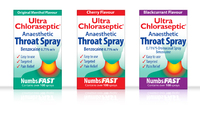Winter health - a real pain in the throat

As winter draws in, sore throats are causing Britain a multitude of problems - including:
Over 35 million days lost from school and work each year due to sore throats in the UK
GP consultations for sore throats cost around £60m per year
1 in 18 sore throat sufferers will consult their GP, costing the NHS valuable time and resources
The trend continues online, with one analysis showing over 315 twitter conversations regarding sore throats in 48 hours alone. Around 30 of these were directly seeking help and advice on how to manage the painful symptoms and side effects of the common sore throat.
With such confusion surrounding the common health complaint, now is the perfect time for consumers to learn what a sore throat actually is and the best way to deal with the symptoms.
What exactly is a sore throat?
A sore throat is the body’s answer to infection. All sore throats are caused by inflammation which manifests itself as swelling, redness, pain and heat. It is this inflammation which shows that your body is fighting off an infection by producing its army of antibodies.
Often, sore throat remedies contain ingredients to treat the infection, which in doing so are negatively interfering with your body’s own natural defences. Ideally, sufferers should go for something that addresses the pain associated with the inflammation, so it does not dampen your body’s reaction but eases the sore throat instead.
If an infection strikes any part of the respiratory tract, from the lungs at the bottom to the nasal passage at the top, it has the potential to spread. With the throat constituting such a large region, infection in one specific area will spread and ultimately result in a sore throat.
Viral or bacterial – that is the question
There are two types of infection which can cause a sore throat – viral and bacterial. In the first instance, consulting your pharmacist will confirm the type of infection which is usually identified by the presence of pus or yellow mucus in the throat area – signalling a bacterial infection.
A bacterial infection is often the cause of more serious sore throats and in the majority of cases treatment will be in the form of antibiotics prescribed by your GP.
A viral infection is the most common of the two, being the source of 90-95% of cases, and does not respond to antibiotics. Therefore the best response is to let it go away on its own and to treat the associated pain. The most common method for this is with an anaesthetic spray or lozenge, with the spray being very effective in delivering the anaesthetic straight to where it hurts. This is also useful for relieving pain with bacterial infections while antibiotics are working.
Expert’s advice
When a sore throat strikes, Dr Mike Smith (who has a special interest in colds and sore throats) believes the best treatment is one that lets the body still do its defensive work, “Get your hands on something that will get straight to the site of the pain, such as an anaesthetic throat spray, but don’t worry about fighting off the overall infection – that’s what your sore throat is doing already.”
Ultra Chloraseptic Anaesthetic Throat Spray – Real relief, real fast
Don’t let a sore throat ruin your day, three sprays straight to the site of pain, can numb sore throats in seconds - no Benzocaine spray is stronger. Comes in three great tasting, sugar-free flavours – Blackcurrant, Cherry and Original Menthol. Available from pharmacies and large supermarkets without prescription. Priced £5.21 with each bottle containing over 30 adult doses (100 sprays). Contains Benzocaine. Always read the label.

